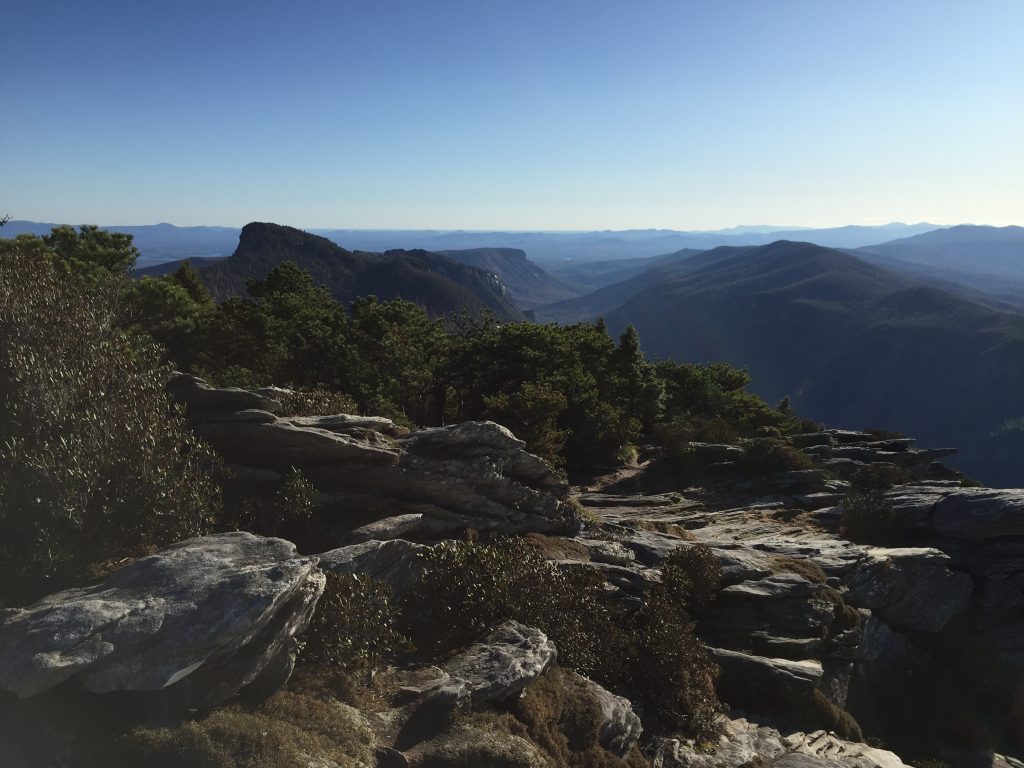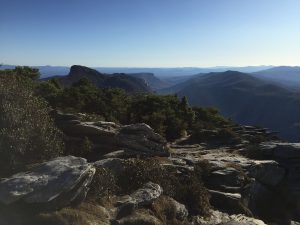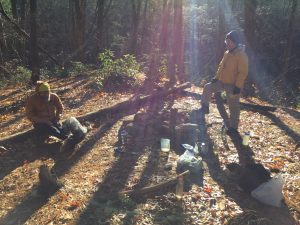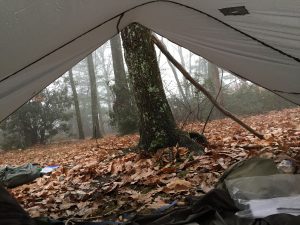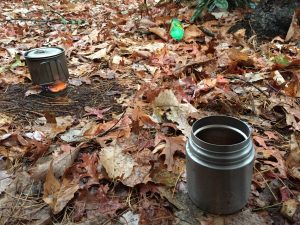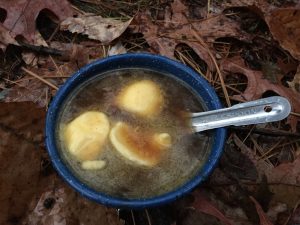I had the opportunity to put my entire crazy Rewilder’s Backpacking system to the test through many weather extremes this weekend.
I jumped on this chance to join a Meetup Group called Educational Backpacking Treks when they were planning a trip to the nearby Linville Gorge Wilderness. I wanted to test my Lucky Sheep gear and ideas for the first time with other backpackers who were using modern gear. I also just wanted to get out with a group that knew some routes I wasn’t familiar with and to have the camaraderie and safety of a group.
At one time I had been a gear junky and on top of the latest trends, but since I left the beaten path to re-invent my backpacking style, I wasn’t exactly sure how my techniques and gear would measure up to the standards of modern backpacking. I was having mixed feelings about my gear wondering if it really worked the way I claim it works. I needed to test it for myself
I was curious to see just what would work and not when juxtaposed to other campers using modern gear who had no idea about my alternatives. When you’re the only one saying something and you are convinced it works, but the world has yet to recognize it, and continues to be skeptical, that is a very tough place to be. You start to ask yourself if you are just deluding yourself or something. For the past several years I have been mystified with natural fibers and rediscovering how to incorporate them into my outdoor gear. My basic hypothesis is: Natural fibers perform better than synthetic in most cases and we would be better off using them in many applications of outdoor gear.
So for me the primary objective, besides just having an amazing time, was to put my gear and theories under rigerous tests and scrutiny without any hidden agenda to prove anything. Testing is completely different than proving. Proof comes AFTER and is dependent on an objective analysis.
We met at a remote trailhead to drop a car off and carpool to the starting point where we would make our way over four days back to the shuttle car. We weighed our packs and everyone was pretty close to a 30 lb. pack including food and water. Mine was almost exactly 30 lbs so I was very pleased it was among the lighter of the packs. So far so good. We have to bear in mind (pardon the pun) that weight isn’t the ONLY thing that matters.
Because there would be several tests which I will list:
- Overall pack weight
- Overall functionality of gear when faced with weather extremes such as rain, cold, wind, etc.
- Carrying not too much and not too little of anything (such as water, food, etc.)
- Overall comfort and enjoyment of the experience. (For instance, even if a pack is light, is the person still warm and well fed and able to adjust to the changing conditions found in nature).
- Having everything you need. Not leaving an important item out. Being prepared for emergencies such as first aid and survival items.
I’m not sure how my own pack was so close in weight to these other modern backpacker’s packs because my sleeping bag and clothes were quit a bit heavier. I believe I saved in other areas in order to make up for the discrepancy but I’m not sure exactly what areas were different. We all had about the same amount of food by weight (eight pounds or two pounds per day). I suspect my tent/shelter is what saved me and also the fact I wasn’t carrying a water filter because I drink water straight from the stream.
We started on at twilight to do a night hike a couple miles which climbed the east rim of Shortoff Mountain. A moist almost summer like wind blew as we carefully stepped over and around objects along the trail. Lights from nearby towns glowed faintly in the distance. Stopping from time to time to soak in the alluring silence, we often caught views of Lake James, which was mostly presented as a massive black zone with no lights, which was right below us.
We made camp and gathered firewood, had dinner and chatted into the night. We woke up to temps around 50 degrees F, and the dreaded rain pounding on our tents. I was somewhat elated because I really wanted to test my gear to the max. Would my wool and waxed cotton clothing and sleeping bag live up to the claims I was making?
We had breakfast in the rain as we discussed the days plans, then went to our tents to pack up.
My gear included:
Base Layer:
- Merino wool top and bottom (2 for bottoms)
- Merino bandana (2)
- Merino Scarf
Insulation Layer:
- Heavy Wool Sweater (handwoven in the Himalayas)
- Wool Socks—3 pairs (one for only sleeping, one for wearing, one for washing)
- Wool Finger Mitts
Shell Layer:
- Waxed Cotton Parka with hood
- Waxed Cotton Pants
- Rain Layer:
- Synthetic Poncho with hood
- Felted Wool Hat
I carefully packed my gear into my backpack and decided what I would wear vs. what I would protect and need later. I knew that whatever I wear may become completely soaked.
What went on my body was:
- One layer of merino base layer for top and bottom (base layer)
- One pair wool socks with leather Minimalist Boots
- Waxed Cotton Pants and Parka (shell layer)
- Wool Finger Gloves
- Merino Bandana on my head
- Wide brimmed wool felt hat
- Waterproof Synthetic poncho
What went in the waterproof stuck sack in my backpack was:
- Lucky Sheep Rewilder Wool Sleeping Bag (four pounds)
- Wool sweater (two pounds)
- One Merino Bottom Base Layer
- 2 Pairs of wool socks
The rest of my pack was exposed to the rain. My food, cooking kit and first aid kit was wrapped in ziplock bags could get wet. My tent and groundcloth were already wet and packed on the outside pockets of the backpack. I put my lunch, water, and stove fuel in an outside pocket. That’s about all I had with me.
This was what most people would call a miserable day…our second day hiking on a four day trip. We started out on the muddy trail as water sloshed into our boots. I felt myself getting wetter and colder with each step.
Our Day Two Agenda was going to be strenuous and windy:
Day 2 (Saturday 11/23) • Details: Sunrise at 7:11. Continue for a couple miles of relatively flat terrain along the east rim. Begin the descent on the MST into Chimney Gap around the 4 mi mark. Reach Chimney Gap (5.8 mi). Water can be found by following a trail to the west about a 1000’ down to the head of Chimney Branch (10 min). Trail is unmarked and can be found behind the campsite on the west side. From Chimney Gap, follow the MST on the ascent to the The Chimneys. This climb is strenuous and gains over 1000’ in 1 mi. The Chimneys is a craggy playground of stone boulders, pillars, & caves. This is a good place to enjoy lunch (if you carry up water) & explore with spectacular views of the eastern piedmont, the gorge itself, & the Black Mountains. Now the MST descends a bit to the Table Rock parking area and after another 0.25 mi forks to continue on the MST (side trail to ascend Table Rock Mountain in another 100 yds) or left takes you on the Little Table Rock Trail.
After a couple hours of cold rain and mist pelting me as I stepped up each rock and sloshed through water puddles I became extremely wet and cold. We stopped to get a little shelter under a rock overhang at The Chimneys. My walking stick was super important as my legs felt weak and wobbly. My fingers became so numb I was glad I packed my giant homemade butter/cacao bar on the outside pack. I could unwrap it and eat a few bites, drink some water, and when it was time to go, pack up and keep up with everyone else’s pace.
I was so cold I didn’t really care about anything at that point other than getting to camp and getting into my dry gear. I was so relieved when the other’s made a plan for just that. We hiked downhill into the Gorge where we would have protection from the wind. When we found the campsite we didn’t need any instruction of what to do. We each dropped our heavy packs and started setting up our tents. Without any words we each disappeared into our shelters. I didn’t care about anything at that point, about if my gear works of not. I could think of nothing other than, getting warm. That is the gift of this kind of trip, where you empty your thoughts of everything but the present moment. Every little move is important and you have no energy to waste on the paste or the future.
What most people would call a miserable day…our second day hiking on a four day trip. I was able to get in my tent and sleeping bag and heat up some hot soup during the rain without leaving my tent (tarp). I wasn’t sure if my gear was working or not. This was as extreme as it gets before I would call it a survival experience. I was so cold it was all I could do to pitch my tarp in the rain, throw my gear in, unpack the dry stuff and take off the wet stuff, crawl into my bag and shiver my way back to life.
I eventually warmed up as the rain continued to pelt, the wind whip the sides of my tarp, and the temperatures drop. Did my gear completely fail? Well, here I was recuperating from an extreme cold/wet exposure, drying out just as planned inside my amazing wool gear. It seemed like it was working pretty darn well. Especially because I could crawl inside my sleeping bag, pull it over my head, and breath. This created a heat source not available to campers with synthetic sleeping bags and clothing, because if they tried it, they would simply become humid and colder. I wouldn’t really know for sure until hours later we crawled back out of our bags to scuttle around in the twilight and dark to get a fire going and sit around comparing notes and tales from this as well as previous adventures…
Stay tuned for Part Two

